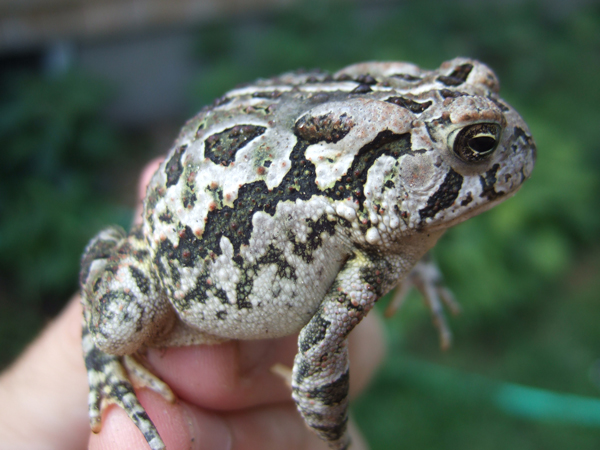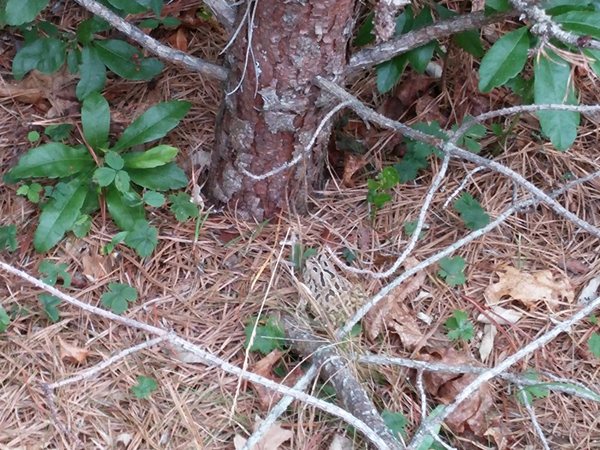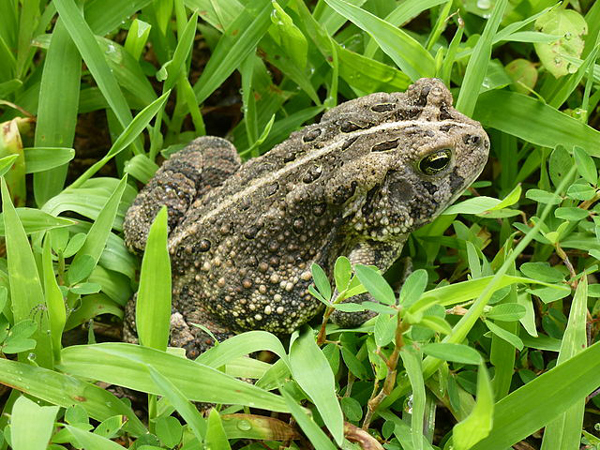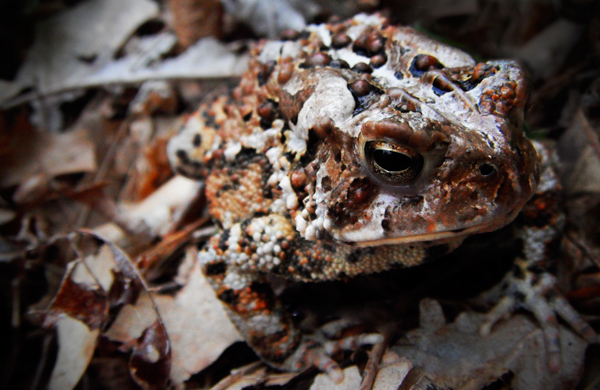Located in Southeast New England (coastal Massachusetts specifically), peninsular Cape Cod extends into the Atlantic Ocean with its 90 miles
Located in Southeast New England (coastal Massachusetts specifically), peninsular Cape Cod extends into the Atlantic Ocean with its 90 miles of ocean shore line, weather dwarfed oak and pine trees, whale watchers and hordes of summer time visitors. Cape Cod is an incredible, rather unique environment developed naturally over four ice aged glacial shifts and which now boasts an amazing landscape and diversity of wildlife. It is a herper's dream!
Fowler's Toad
- Family: Bufonidae
- Adult Size: 2 to 5 inches in length.
- Range: Wide ranging from the East Coast down to the Gulf Coast (excluding coastal South Carolina, Georgia and most of Florida), west to east Texas and north to Missouri and south Illinois. Generally absent from extreme western third of North America and portions of north western states up to western Great Lakes region.
- Habitat: Woodlands, prairies, meadows, and beaches.
- Care Level: Beginner
The Cape is an environment that has seen unimaginable environmental pressures and change and is sadly an environment that has an uncertain future…
However despite the uncertainty, there is one amphibian that has remained constant and has flourished throughout the DDT pesticide disaster from the 1940's throughout the 1960's, it has survived years of government induced jet fuel contamination and the explosive habitat fragmentation that still runs rampant today. It is an unobtrusive denizen of the sandy beaches and cranberry bogs from which Cape-Cod is so well known, it is the adorable fellow known as Fowler's Toad!

leo spinner
A beautiful example of Fowler's toad from Cape Cod.
Fowler's Toad History
The Fowler's Toad, rather large at 2 1/2 to 5 inches (6-12.7 cm) was first described in 1882 by Mary H. Hinckley of Milton, Massachusetts. She was a known authority on the study of Batrachia Salientia and she so named her current study after Samuel Page Fowler, a naturalist from Danvers, Massachusetts and the cousin of Frederick Ward Putnam, a dear friend of Mrs. Hinckley. (Lazell Jr. 1964) Information is obscure at best as to what degree of research was actually contributed directly by Mr. Fowler on this species if any, however at any rate, so the toad was christened, Mr. Fowler's Toad.
Range and Description
The Fowler's Toad is a subspecies of the Woodhouse Toad (Bufo woodhousei) and shares its sub-specific status with the Southwestern Toad B. w. australis and the East Texas toad B. w. velatus. The species is relatively widespread and confined to North America. It is generally absent from the extreme western third of North America and portions of the north western states up to the western Great Lakes regions.
From here we will focus specifically on B. w. fowleri which is found primarily in the eastern United States from Lake Michigan, east through most of Pennsylvania to south eastern New York and throughout southern New England.
Fowler’s toad is also well known south to the Gulf Coast (excluding coastal South Carolina, Georgia and most of Florida), west to east Texas and north to Missouri and south Illinois. (Behler and King 1979) B.w.fowleri although similar is slightly larger than Bufo americanus with whom much of its range is shared. In Massachusetts where the author is from, they are the only two species of true toads and are often confused with one another by the inexperienced.
There are several notable physical differences however which readily distinguishes one from the other. The Fowler's toad is laden with large darkened areas over the dorsum, there may be as many as six or more bumps or (warts) contained in each of these darkened areas as compared to one or two bumps contained in the much smaller darkened areas of B. americanus.
The belly of the Fowler's toad is immaculate white, lacking the widespread freckling which is so familiar to the American toad. There are cranial crests present on both species and notable paratoid or Poison glands located adjacent to these crests. The paratoid glands of B. w. fowleri come into much contact with the cranial crests where as in B. americanus, they do not.
The Fowler's toad tends to be much more colorful and attractive than the American toad, often adorned with shades of white and green as well as beige, brown and black. Bufo w. fowleri may also have lemon yellow and black striping along the back of the thighs. The American toad is rather uniform in color, a caramel to dark brown only occasionally having splashes of red and or orange.
Fowler's Toad Behavior
The Fowler's toad is primarily nocturnal but is seen in daylight hours with greater frequency than the American toad. It is not unusual to encounter this pleasant animal while working in the garden. It is rarely bothered by the presence of humans and will often just sit loosely in the grass while you work around it!

leo spinner
A wonderfully camouflaged specimen of Fowler's toad as it was discovered on Cape Cod.
Although Fowler's toads may struggle a bit when handled, they are less vocal than the chirping American Toad and is less likely to urinate on your hands in an effort to get down! It is a common site beneath street lamps, happily gobbling up its own weight in invertebrates each night. It is not unusual of course for the Fowler's toad in all of her feeding fury to try and over come larger organisms such as other toads, small snakes and even small mammals. I have observed these toads as well as other species of Bufo utilizing their digits (toe tapping) presumably in an effort to attract prey. When food is introduced in moderate amounts, the toads will begin rapidly tapping their elongated rear toes. This may very well be just an indication of excited stimulation. In any event, it warrants further research. This behavior has also been observed by the author in specimens of Ambystoma maculatum, the spotted salamander. Juveniles of this salamander species will raise a hand off the ground and turn it continuously from right to left again presumably in an effort to attract the attention of prey animals.
As a boy I can recall encountering the Fowler's toad during the early morning twilight hours when my dad would awaken me for pond or lake fishing. I remember how chilly the early morning air seemed and while standing at the water's edge, I would watch these amazing toads beneath the street lamps. They seemed so content and tolerant of the chilly early morning air. It was a different world I was observing, a world I almost seemed to be intruding on.
As these toads are predators, they are also hunted as prey. Though many animals have a curiosity which can prove dangerous to these toads, there are few that will actually attempt to eat them. It seems to be common knowledge with most house hold pets as well as Raccoons, Skunks, Birds and such that the Fowlers toad is not a delicious meal! When threatened, this one, like many species of North American Toad inflates its lungs in an effort to appear larger, raises itself up high on its legs and presents an oily toxin from the paratoid glands on the top of the head. These tactics are usually enough to ward of curious onlookers or potential predators.
There is however one dreadful enemy to the Fowler's toad and that is the North American hognose snake (Heterodon). This reptile has a highly developed rear fang mechanism which acts as the perfect tool for holding onto an inflated toad! It has been speculated that the fangs of the hognose snake are used to deflate the toad allowing for greater ease of swallowing. It is however in my experience that this is not the case. Much in the same way that a needle can be pushed through a balloon with out popping it if at first a piece of clear tape is applied to the balloon, so acts the muscles and membranes surrounding the lungs of a toad, making it biologically impossible to "pop" a toad by means of direct penetration.
In any event, the hognose snakes are specifically designed for routing toads out of the soil with their upturned snouts and have developed a resistance to the toad's Bufo toxins. It is actually suggested that the hognose snake stores properties of the toad poisons in its well developed Duvernoys gland, presenting it to be considered a mildly venomous species. An interesting story was conveyed to me by a dear friend and naturalist who had told me of an eastern Hognose specimen that she witnessed which had swallowed a Fowler's toad and died within a few days there after. Upon inspection of the snake and toad during necropsy, she found the toad to have been full of over a dozen yellow jacket bees. Perhaps during digestion, toxins from the bees had entered the snake's system and led to its untimely demise. But more interesting is the fact that this toad had consumed so many yellow jackets and had not been bothered so much as to stop eating after the first bite!
Breeding the Fowler's Toad
In the north eastern states, the Fowler's toad awakens from hibernation in early spring around mid April, a little later than the American toad which rises in early March. She breeds sometime later as well. It is nearing the second week of May before spring rains encourage the soft and gentle sheep-like calls that are indicative of this species. These toads move directly from the soft sand where they have spent the past several months in stasis, into the cool shallow edges of marshy bogs, vernal pools and clear, shallow water swamps. They often call late in the day and into the night, rarely if ever during late morning or mid daylight hours. This is not the case with Americanus which may call throughout the day with a long drawn out trill.

Bob Warrick
A Fowler's toad in the Missouri Ozarks.
Fowler's toads typically breed from May to June in the north east, however they may breed as late as August in other parts of its range.
Males swim about in the shallows, calling and seeking out receptive females. When a female is found, her suitor begins the climb onto her back and performs a nuptial embrace known as amplexus. With his tiny hands pressed tightly beneath her arm pits, he anxiously holds on for hours or in some cases days awaiting her moment of egg deposition.
At this time, he will release his genetic material over the gelatinous eggs as they are being laid. Fertilization is completely external. The eggs quickly absorb sperm and water and are formed into long translucent strands. These translucent and somewhat iridescent strands are speckled with the miniature black eggs which will develop into thousands of tiny, black pollywog's only days later.
The pollywog's will hatch and swim in large organized groups not dissimilar to the way fish and birds organize the motion known as emergent complexity.
In the past, Fowleri and Americanus were generally kept apart due to habitat preference and natural boundaries. Americanus preferring the wooded hillsides and pine forest whereas the Fowleri were more inclined to the lower lying sandy coastal and bog areas.
Habitat fragmentation has opened doors however and where ecological segregation is weak the two species of toads cross paths. Hybridization sometimes occurs and individual offspring may be produced with characteristics of both species.
As the breeding season comes to an end, the toads leave the water and wander not so far from their home range, consuming everything they can overpower in their paths in an effort to retain the fat stores that will carry them through the winter and the following breeding season.
Everything with this species is done within a general home range area. Preferred haunts will have an ideal food supply, water for breeding and soft earth for hibernating all within close range of one another.
Captive Care of the Fowler's Toad
Fowler's toads make wonderful captives. They require very little room and are considerably less active than the American toads, which is to say that you are not likely to be awakened in the night by the sound of these organisms wrestling with one another or bumping their tiny heads against the enclosure walls in an effort to move along to their next adventure!

jimpaz/wikipedia
A Fowler's toad showing its camouflage capabilities.
My Fowler's toads are contained in groups of six individuals to a 20 gallon long tank, much the same as I house American toads.
I use several inches of ground pine bark mulch as a substrate. This ground bark mulch is high in acid which retards the growth of aggressive bacteria and prevents the onset of fungus. Ground pine bark mulch also has a great retention/evaporation ratio of water.
When the toads are placed into the tank, after a moment of acclimation, they will begin to burrow into the substrate. It’s at this time that I saturate the mulch with fresh water. The toads will typically urinate and drink via cloacal absorption. Perfusion of water also occurs through the soft white underbellies of the toads.
I generally leave the tanks in this condition. I do not use a water bowl or cage adornments primarily due to ease of maintenance.
It is understood that cage adornments should be left up to the keeper to decide of course and they can be rather aesthetically pleasing to the human eye. I would also like to suggest that the presence of smooth stones, branches and artificial foliage may contribute to the well being of your captive individuals, providing some form of environmental enrichment. There has not been much if any in the way of research concerning the needs of lower vertebrates and invertebrates as far as visual stimulation and enrichment are concerned but again, I believe it warrants investigation.
At any rate, once evaporation has left the pine bark mulch completely dry on the surface and moderately damp below, I re-saturate the substrate with fresh water and allow the process to take place once again.
After the second cycle of evaporation, my toads are removed and looked over for any signs of distress. They are placed in a tub of cool shallow water in which they will typically urinate and drink. I remove and recycle to the garden, the old bark mulch and replace it with fresh mulch.
The old mulch that has been removed is saturated with ammonia's and solid fecal waste material and must not be reused in the enclosure.
My toads are fed primarily captive produced European house crickets. They are readily available in any necessary size and can and should be gut loaded before feeding to your captives. This introduces a greater array of nutrients into your toads for better health.
Other species are sometimes fed to my toads including isopods (sow bugs), small beetles, moths and live pinkie mice. If you're really motivated, you can place the toad enclosure outdoors beneath the porch lamp for several hours in warm weather and see what the toads can attract themselves!
I feed my toads daily and will dust their food once a week with a calcium/vitamin D powder.
Captive Breeding The Fowler's Toad
Captive breeding is achieved with relative ease in this species. Ideally if you live in a climate that is comparable to the climate with which these toads are naturally from, they can simply be kept outdoors throughout the year. Be sure that all of their environmental needs are met of course.
Indoors these animals are cooled preferably to temperatures as low as 45 degrees Fahrenheit. This is why outdoors works better!
In any event, this cooling is done in mid to late fall when the days have become noticeably shorter around mid October early November and should be done gradually over the course of two to three weeks.
The toads should be kept in hibernation for at least three, preferably four months after which time you will gradually increase temps again over the course of a few weeks ultimately reaching comfortable temps of upper 60's to lower 70's. If your toads have been kept outdoors annually, then the natural cycle of spring rains will induce breeding as described earlier in this article. If they are kept indoors then you will want to stimulate breeding using a spray bottle and home made rain chamber. Within a week or so of hibernation, your toads can be sprayed several times a day with a misting bottle. This will tell the animals that everything is falling into place!
After this time, your toads should be moved into a rain chamber. This chamber can be made rather simply using two medium sized plastic totes, two small recirculating pumps and two small submersible filters. Each of the totes should be filled with four or five inches of fresh water. Each tote will contain a recirculating pump. You must remember, if you use a stronger pump be sure to protect your toads and their eggs from the pump impeller's vacuum! Create a small cage around the pump. This should also be applied for a stronger filter as well.
The tote which will house your captive toads should have a fine mesh screened cover over it. The water from the other tote will cascade across this mesh cover mimicking the sound and activity of rain, however crudely it may be. Once the rain chamber is initiated, it should be allowed to run continuously. You should pay close attention that the water is not being lost somewhere in the design of your chamber.
Breeding calls and amplexus should be achieved within the first few nights of rain chamber activation and it will likely only be within a few days from there before egg strands are laid. Once the eggs have been laid, remove adult toads and replace them to their normal enclosures. Eggs and pollywogs may be reared directly in the totes that they are in.
It is essential that proper hygiene be maintained. Water should be refreshed daily with clean water of the same general room temperature as is found in the rearing totes. This is especially important once the pollywog's have emerged and are feeding. Newly emerged pollywog's can be maintained on fresh green algae and flake fish food. Any uneaten fish food should be removed in a timely manner in order to prevent rapid growth of unwanted bacteria.
Monitor your pollywogs closely once they have started to develop legs, it is important to be sure these tiny organisms will be able to leave the water.
Fully developed baby toads should be removed and set up much the same way that your adults are kept. They may be fed the same way. Be sure to watch for neonates that fail to thrive and remove them upon any signs of poor health or of course death.
In Closing
Fowler's toads like many other species of this genera can make extraordinary captives. There is something special about a toad, an unspoken wisdom perhaps. Regardless, the captive Fowler's toad can afford you a very rewarding relationship that may last as long as several years.
Treat your toads right and get the most out of any captive care project you may endeavor. There is nothing more rewarding than following through with a captive care and breeding project! It's an experience most people will never know or perhaps understand but if you've read this article from start to finish, then you have the interest and you have what it takes to know this rewarding feeling of accomplishment and you should follow through with it.
To all of you, I wish you all of my best.
Leo Spinner is a native of Cape-Cod, Massachusetts and has been keeping and studying Reptiles, Amphibians and Invertebrates in captivity for over 45 years. He owns and operates “The Spotted Turtle Herpetological Institute” & “Skin & Scales Exotic Reptile & Amphibian Presentations” and performs these presentations along the eastern seaboard. He resides in Massachusetts with his family.


